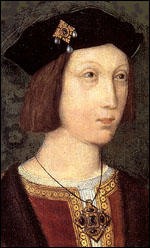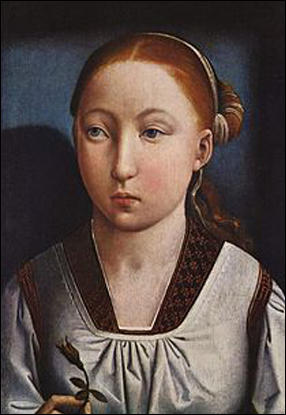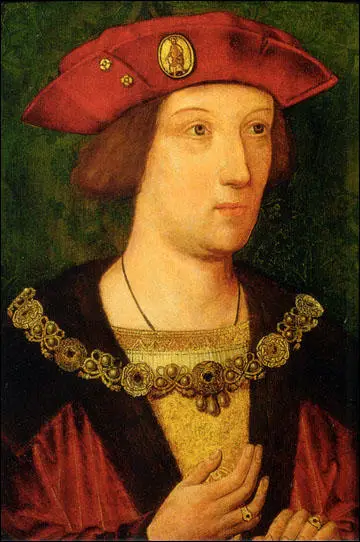Prince Arthur

Arthur, the first son of Henry VII was born at St Swithun's Priory, Winchester, on 19th September 1486. He was born prematurely and spent the first months fighting for his life. (1)
Henry, who had become king in 1485, was determined that the Tudor family should rule England and Wales for a long time. To do this he needed to protect himself from those who had the power to overthrow him. His first step was to marry Elizabeth of York, the eldest child of Edward IV. (2)
Arthur was baptized on 24th September in Winchester Cathedral and named after the famous British hero whose fabulous exploits fill the pages of Geoffrey of Monmouth. Initially he was put into the care of women and his nursery at Farnham. This was headed by Dame Elizabeth Darcy. (3)
Spain, along with France, were the two major powers in Europe. Henry VII constantly feared an invasion from his powerful neighbour. Ferdinand of Aragon and Isabella of Castile were also concerned about the possible expansionism of France and responded favourably to Henry's suggestion of a possible alliance between the two countries. In 1487 King Ferdinand agreed to send ambassadors to England to discuss political and economic relations. (4)
In March 1488, the Spanish ambassador at the English court, Roderigo de Puebla, was instructed to offer Henry a deal. The proposed treaty included the agreement that Henry's eldest son, Arthur, should marry Catherine of Aragon in return for an undertaking by Henry to declare war on France. Henry enthusiastically "showed off his nineteen-month-old son, first dressed in cloth of gold and then stripped naked, so they could see he had no deformity." (5)
Puebla reported that Arthur had "many excellent qualities". However, they were not happy about sending their daughter to a country whose king might be deposed at any time. As Puebla explained to Henry: "Bearing in mind what happens every day to the kings of England, it is surprising that Ferdinand and Isabella should dare think of giving their daughter at all." (6)
Catherine of Aragon and Prince Arthur
The Treaty of Medina del Campo was signed on 27th March 1489. It established a common policy towards France, reduced tariffs between the two countries and agreed a marriage contract between Prince Arthur and Catherine of Aragon and also established a dowry for Catherine of 200,000 crowns. This was a good deal for Henry. At this time, England and Wales had a combined population of only two and a half million, compared to the seven and a half million of Castile and Aragon, and the fifteen million of France. Ferdinand's motivation was that Spanish merchants wishing to reach the Netherlands, needed the protection of English ports if France was barred to them. The English also still controlled the port of Calais in northern France. (7)
However, the marriage was not guaranteed. As David Loades points out: "The marriage of a ruler was the highest level of the matrimonial game, and carried the biggest stakes, but it was not the only level. Both sons and daughters were pieces to be moved in the diplomatic game, which usually began while they were still in their cradles. A daughter, particularly, might undergo half a dozen betrothals in the interests of shifting policies before her destiny eventually caught up with her." (8)

In August 1497, Prince Arthur and Catherine were formally betrothed at the ancient palace of Woodstock. The Spanish ambassador, Roderigo de Puebla, standing proxy for the bride. "De Puebla's own role, a conventional one by the standards of the time, was that of the bride; as such he not only took the prince's right hand in his own and was seated at the King's right hand at the subsequent banquet but also inserted the statutory symbolic leg into the royal marriage bed." (9)
Catherine arrival was delayed until Prince Arthur was able to consummating the marriage. Catherine was also encouraged to learn French as very few people in the English court spoke Spanish or Latin. Queen Elizabeth also suggested she accustom herself to drink wine, as the water in England was not drinkable. (10)
Catherine and Prince Arthur wrote several letters to each other. In October 1499 Arthur wrote to her thanking her for the "sweet letters" she had sent him: "I cannot tell you what an earnest desire I feel to see your Highness, and how vexatious to me is this procrastination about your coming. Let it be hastened, that the love conceived between us and the wished-for joys may reap their proper fruit." (11)
Catherine left the port of Corunna on 20th July 1501. Her party included the Count and Countess de Cabra, a chamberlain, Juan de Diero, Catherine's chaplain, Alessandro Geraldini, three bishops and a host of ladies, gentlemen and servants. It was considered too dangerous to allow Ferdinand of Aragon and Isabella of Castile to make the journey. The sea-crossing was terrible: a violent storm blew up in the Bay of Biscay, and the ship was tossed about for several days in rough seas and the captain was forced to return to Spain. It was not until 27th September, that the winds died down and Catherine was able to leave Laredo on the Castilian coast. (12)
Catherine of Aragon arrived in England on 2nd October 1501. Arthur was just fifteen, and Catherine nearly sixteen. (13) As a high-born Castilian bride, Catherine remained veiled to both her husband and her father-in-law until after the marriage ceremony. Henry would have been concerned by her size. She was described as "extremely short, even tiny". Henry could not complain as Arthur, now aged fifteen, was very small and undeveloped and was "half a head shorter" than Catherine. He was also described as having an "unhealthy" skin colour. (14)
Marriage
Arthur and Catherine married on 14th November 1501, at St Paul's Cathedral in London. That night, when Arthur lifted Catherine's veil he discovered a girl with "a fair complexion, rich reddish-gold hair that fell below hip-level, and blue-eyes". (15) Her naturally pink cheeks and white skin were features that were much admired during the Tudor period. Contemporary sources claim that "she was also on the plump side - but then a pleasant roundness in youth was considered to be desirable at this period, a pointer to future fertility". (16)

The couple spent the first month of their marriage at Tickenhill Manor. Arthur wrote to Catherine's parents telling them how happy he was and assuring them he would be "a true and loving husband all of his days". They then moved to Ludlow Castle. Arthur was in poor health and according to William Thomas, Groom of his Privy Chamber, he had been over-exerting himself. He later recalled he "conducted him clad in his night gown unto the Princess's bedchamber door often and sundry times." (17)
Alison Weir has argued that Arthur was suffering from consumption: "There was concern about the Prince's delicate health. He seems to have been consumptive, and had grown weaker since the wedding. The King believed, as did most other people, that Arthur had been over-exerting himself in the marriage bed." (18) Almost thirty years later Catherine deposed, under the seal of the confessional, that they had shared a bed for no more than seven nights, and that she had remained "as intact and incorrupt as when she emerged from her mother's womb". (19)
Death of Prince Arthur
Antonia Fraser, the author of The Six Wives of Henry VIII (1992) has argued that she believes the marriage was unconsummated. "In an age when marriages were frequently contracted for reasons of state between children or those hovering between childhood and adolescence, more care rather than less was taken over the timing of consummation. Once the marriage was officially completed, some years might pass before the appropriate moment was judged to have arrived. Anxious reports might pass between ambassadors on physical development; royal parents might take advice on their offsprings' readiness for the ordeal. The comments - sometimes remind one of those breeders discussing the mating of thoroughbred stock, and the comparison is indeed not so far off. The siring of progeny was the essential next step in these royal marriages, so endlessly negotiated." Fraser goes on to argue that the Tudors believed that bearing children too young might damage their chances of having further children. For example, Henry VII's mother, Margaret Beaufort, was only thirteen when she had him and never had any other children in the course of four marriages. (20)
On 27th March 1502, Arthur fell seriously ill. Based on the description of symptoms by his servants, he appeared to have been suffering from a bronchial or pulmonary condition, such as pneumonia, tuberculosis or some virulent form of influenza. David Starkey has suggested he might have been suffering from testicular cancer. (21) Antonia Fraser, believes that as Catherine was also ill at the same time, the both might have had sweating sickness. (22)
Arthur died on Saturday, 2nd April, 1502.
Primary Sources
(1) Antonia Fraser, The Six Wives of Henry VIII (1992)
In an age when marriages were frequently contracted for reasons of state between children or those hovering between childhood and adolescence, more care rather than less was taken over the timing of consummation. Once the marriage was officially completed, some years might pass before the appropriate moment was judged to have arrived. Anxious reports might pass between ambassadors on physical development; royal parents might take advice on their offsprings' readiness for the ordeal. The comments - sometimes remind one of those breeders discussing the mating of thoroughbred stock, and the comparison is indeed not so far off. The siring of progeny was the essential next step in these royal marriages, so endlessly negotiated.
Where an heiress was concerned, her "spoiling" by being obliged to have sex and bear children too young might have important consequences. The physique of the great heiress Margaret Beaufort was considered to have been ruined by early childbearing. She bore the future Henry VII when she was only thirteen, and never had any other children in the course of four marriages. Henry survived, but the existence of a single heir was in principle a great risk to any family in this age of high infant mortality, as the shortage of Tudor heirs would continuously demonstrate.
Student Activities
Henry VIII (Answer Commentary)
Henry VII: A Wise or Wicked Ruler? (Answer Commentary)
Henry VIII: Catherine of Aragon or Anne Boleyn?
Was Henry VIII's son, Henry FitzRoy, murdered?
Hans Holbein and Henry VIII (Answer Commentary)
The Marriage of Prince Arthur and Catherine of Aragon (Answer Commentary)
Henry VIII and Anne of Cleves (Answer Commentary)
Was Queen Catherine Howard guilty of treason? (Answer Commentary)
Anne Boleyn - Religious Reformer (Answer Commentary)
Did Anne Boleyn have six fingers on her right hand? A Study in Catholic Propaganda (Answer Commentary)
Why were women hostile to Henry VIII's marriage to Anne Boleyn? (Answer Commentary)
Catherine Parr and Women's Rights (Answer Commentary)
Women, Politics and Henry VIII (Answer Commentary)
Cardinal Thomas Wolsey (Answer Commentary)
Historians and Novelists on Thomas Cromwell (Answer Commentary)
Martin Luther and Thomas Müntzer (Answer Commentary)
Martin Luther and Hitler's Anti-Semitism (Answer Commentary)
Martin Luther and the Reformation (Answer Commentary)
Mary Tudor and Heretics (Answer Commentary)
Joan Bocher - Anabaptist (Answer Commentary)
Anne Askew – Burnt at the Stake (Answer Commentary)
Elizabeth Barton and Henry VIII (Answer Commentary)
Execution of Margaret Cheyney (Answer Commentary)
Robert Aske (Answer Commentary)
Dissolution of the Monasteries (Answer Commentary)
Pilgrimage of Grace (Answer Commentary)
Poverty in Tudor England (Answer Commentary)
Why did Queen Elizabeth not get married? (Answer Commentary)
Francis Walsingham - Codes & Codebreaking (Answer Commentary)
Codes and Codebreaking (Answer Commentary)
Sir Thomas More: Saint or Sinner? (Answer Commentary)
Hans Holbein's Art and Religious Propaganda (Answer Commentary)
1517 May Day Riots: How do historians know what happened? (Answer Commentary)
